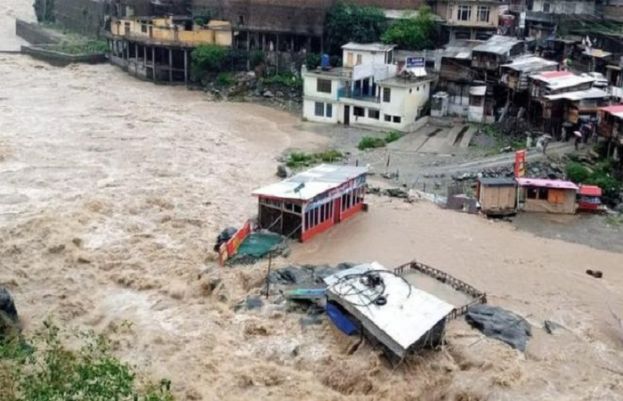
The forecast predicts rain, storms, and hail, probably resulting in flash floods and landslides throughout the nation.
“Hailstorms can injury crops and infrastructure. Folks ought to keep away from pointless journey and crossing rivers and canals. Restore mud homes and guarantee water drainage,” the NDMA stated, urging residents to avoid electrical poles and bushes in case of lightning. It suggested farmers to plan their harvest, particularly wheat, in accordance with the climate.
The warning comes at a time when crops are able to be harvested, particularly the wheat crop.
Extended spells of rain have already delayed wheat harvest within the Potohar area. Farmers within the space have complained about an unprecedented rise in the price of harvest, saying it has doubled in comparison with final 12 months as a result of a rise in gasoline costs.
Although the harvest has begun in some components of the plateau, farmers have been anxious that the premature rains would have an effect on the yield. Additionally they fret concerning the rise in electrical energy, labour and agricultural equipment prices.
In the meantime, the Pakistan Meteorological Department (PMD) has additionally flagged the onset of a westerly wave that might exacerbate situations by means of April 30. This method is predicted to deliver widespread rain and thunderstorms, notably impacting Khyber Pakhtunkhwa, Gilgit-Baltistan, Galiyat, Murree, and Azad Jammu and Kashmir.
The PMD stated the anticipated heavy rainfall and thunderstorms posed dangers of highway disruptions, notably affecting travellers and vacationers. Authorities have urged people to watch climate updates earlier than embarking on journeys. Disruptions in electrical energy and different utility providers have been additionally anticipated. Along with the dangers posed by heavy rainfall, flash flooding in native streams and river tributaries, in addition to landslides and mudslides, have been potential hazards in higher KP, Galiyat, Murree, GB and AJK. Farmers have been suggested to take further precautions and regulate agricultural actions accordingly.
The PMD additionally warned that Balochistan would proceed to expertise hostile climate situations, together with heavy rainfall, resulting in flash flooding in native nullahs and hill torrents within the Sulaiman and the Kirthar mountain ranges.
The brand new spell of heavy rains with thunderstorms that began in Balochistan on Thursday continued on Friday, triggering flash floods.
Within the border city of Taftan, a person was swept away within the flash flood whereas a lady and her daughter have been injured in a lightning strike on their home.
The loss of life toll from rain-related incidents in Balochistan reached 19 whereas round 250 homes have been washed away and about 1,850 partially broken.
Officers stated that 14 highways and hyperlink roads have been badly affected within the flash floods that suspended site visitors between Balochistan and different provinces.
Punjab rains
In the meantime, Punjab, together with town of Lahore, skilled gentle showers and sporadic hailstorms on Friday afternoon, as predicted by the Met Workplace.
Whereas it was a gentle bathe, with the rainfall measuring a most of 10mm at one among Lahore’s 16 Water and Sanitation Company monitoring stations, it has heightened considerations amongst farmers already dealing with declining market charges for wheat and potential crop injury.
Meteorological officers stated the rain system, originating from India, is predicted to accentuate, bringing widespread showers to central and northern Punjab on Saturday. “Right now, it rained solely in Lahore, with Sargodha and Bhakkar areas receiving traces. However within the subsequent 24 hours, all areas of central and northern Punjab might get heavy rains, with thunder, hail and windstorms. In climatic phrases, there may be nothing to trouble. However in an agricultural context, it poses vital dangers,” a Met Workplace worker stated.
Farmers, hoping for a slight restoration in wheat costs, had postponed harvesting. Nevertheless, the current climate situations have solely exacerbated their plight, soaking and probably ruining the crops.
“The April climate has at all times been unpredictable, however with climatic change taking impact, it has turned nasty this 12 months,” stated Amanullah, a wheat farmer from Okara.
Persistent sturdy winds have been damaging the standing crop for the reason that begin of the month. This various diploma of harm happened as a result of, in April, the crop’s stems lose contact with soil, and even gentle wind can result in uprooting.
The state of affairs is additional difficult by the financial backdrop. Regardless of a probably file yield, wheat costs have plummeted, with charges starting from Rs3,000 to Rs3,200 per maund, representing a lack of Rs700 to Rs900 for farmers.
The delay in harvesting was a technique to mitigate a market glut and hope for worth stabilisation, contingent on an aggressive procurement technique by the Punjab authorities — a transfer that has not materialised.
As Punjab has harvested solely about 10 per cent of its wheat up to now, the rest of the crop is susceptible to ongoing hostile climate situations.
“It’s a grim situation for us,” Amanullah lamented. “Caught between a crashing market, an unsympathetic authorities, and now the fury of Mom Nature, we’re bracing for the affect and hoping for the perfect.”



